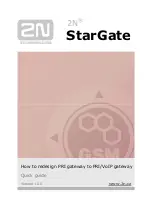
54
Application Setup Screen gains the extra fields needed to
describe a custom special application. These are shown in
Figure 52
below.
Figure 52
Custom Special Applications Setup Screen
■
Application Name
— Each special application is named and
will detect the ports that need to be opened so you do not
need to specify them. This name is not used by the Router
and is only to enable you to identify the connection.
■
Trigger Port
— This is the TCP/IP port number that the Router
uses to recognize the outgoing packet that starts special
application session. Your application provider can provide you
with this information.
The Router allows Trigger Ports that are a single value or a range
of values but not a list. So ‘6599’ and ‘6577-6587’ are both valid
but ‘6577, 6579, 6582’ is not.
■
Specify Protocol
— Select the protocol (TCP or UDP) that your
special application uses. Your application provider can provide
you with this information.
■
Multiple Hosts Allowed
— If your application provider uses
more that one IP address during a session or responds from
an address different to the one you use to start the special
application then you must ensure that the
Multiple Hosts
Allowed
box is checked. Otherwise leave it clear. Your
application provider can provide you with this information.
CAUTION:
Selecting
Multiple Hosts Allowed
weakens the
security that your Router’s firewall is able to provide and should
only be used if the special application requires it.
■
Timeout
— Enter the number of seconds the Router should
wait for the first reply from the special application server
before it abandons the connection.
The default Timeout is three seconds. If you find that
connections are being dropped enter a higher value.
■
Session Chaining
— Some special applications need to take
control of a session. If the special application you wish to run
requires this, ensure that
Session Chaining
is enabled,
otherwise ensure that it is disabled.
CAUTION:
Allowing
Session Chaining
weakens the security that
your Router is able to provide and should only be used if the
special application requires it.
■
Address Translation Type
— If your special application provider
embeds IP addresses in TCP or UDP packets you will have to
enable address translation on the appropriate protocol type.
Your application provider can provide you with this
information.
When you have configured your special application click
Add
to
save your changes or
Close
to quit without making any changes.
dua08609-5aaa01.book Page 54 Thursday, September 11, 2003 12:15 PM
Summary of Contents for OfficeConnect
Page 1: ...dua08609 5aaa01 book Page 1 Thursday September 11 2003 12 15 PM ...
Page 6: ...6 dua08609 5aaa01 book Page 6 Thursday September 11 2003 12 15 PM ...
Page 14: ...14 dua08609 5aaa01 book Page 14 Thursday September 11 2003 12 15 PM ...
Page 22: ...22 dua08609 5aaa01 book Page 22 Thursday September 11 2003 12 15 PM ...
Page 74: ...74 dua08609 5aaa01 book Page 74 Thursday September 11 2003 12 15 PM ...
Page 84: ...84 dua08609 5aaa01 book Page 84 Thursday September 11 2003 12 15 PM ...
Page 90: ...90 dua08609 5aaa01 book Page 90 Thursday September 11 2003 12 15 PM ...
Page 98: ...98 dua08609 5aaa01 book Page 98 Thursday September 11 2003 12 15 PM ...
Page 104: ...104 dua08609 5aaa01 book Page 104 Thursday September 11 2003 12 15 PM ...
















































